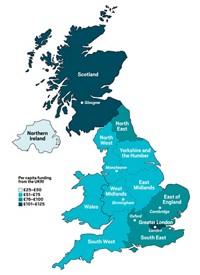Advertisement
Grab your lab coat. Let's get started
Welcome!
Welcome!
Create an account below to get 6 C&EN articles per month, receive newsletters and more - all free.
It seems this is your first time logging in online. Please enter the following information to continue.
As an ACS member you automatically get access to this site. All we need is few more details to create your reading experience.
Not you? Sign in with a different account.
Not you? Sign in with a different account.
ERROR 1
ERROR 1
ERROR 2
ERROR 2
ERROR 2
ERROR 2
ERROR 2
Password and Confirm password must match.
If you have an ACS member number, please enter it here so we can link this account to your membership. (optional)
ERROR 2
ACS values your privacy. By submitting your information, you are gaining access to C&EN and subscribing to our weekly newsletter. We use the information you provide to make your reading experience better, and we will never sell your data to third party members.
Research Funding
Funding basic science in South Korea
by Bibiana Campos Seijo
October 19, 2019
| A version of this story appeared in
Volume 97, Issue 41
I wanted to follow up on my editorial from last week, which was about a trip to Seoul, South Korea, at the beginning of October to attend a forum on nanomaterials that ACS Publications held in partnership with South Korea’s Institute for Basic Science (IBS) at Yonsei University.
The little bit of research I did about South Korean scientific endeavors before the trip suggested that the country probably does not get as much attention as it deserves. Did you know that, according to the United Nations Educational, Scientific, and Cultural Organization, South Korea is the highest-spending country in the world in terms of R&D as a percentage of gross domestic product? It currently invests 4.3% of GDP in R&D, which is well above nations such as the US and China, which score 2.7% and 2.0%, respectively. South Korea has only about 51 million inhabitants in 2019 versus the US’s 329 million and China’s 1.4 billion, according to UN data, but it punches above its weight and currently has the 11th-highest GDP of any economy in the world. The UK seems an apt benchmark, as its population stands at 67 million in 2019. The UK has the 7th-largest GDP, and its investment in R&D is a mere 1.7%.
What this means is that South Korea really understands how much innovation contributes to economic growth, sees science as an economic engine, and is willing to invest. There is strong R&D spending (total spending in purchasing power parity dollars, or PPP$, is $73 billion), of which the business sector contributes 78.2%—by comparison, the UK’s business sector contributes 65.1% of $44 billion PPP$. But South Korea’s government is not standing still. During my visit I heard a lot about the IBS, a government-funded institution that is modeled on the Max Planck Society in Germany and Riken in Japan and whose job it is to conduct “large-scale, long-term and group research in basic science.” With a vision of “Making Discoveries for Humanity & Society,” the IBS was established in November 2011 and is currently in what the organization refers to as a growth phase. For example, its ongoing infrastructure expansion will culminate in 2021 when its RAON, a large facility built around a heavy-ion accelerator that will allow production and study of new rare isotopes, is scheduled to open.
Here are some numbers that give you an idea of the scale of operations at the IBS: The institute is made up of more than 30 research centers spread across the whole of South Korea covering research in not just chemistry but also mathematics, physics, earth science, and more. It counts almost 1,800 researchers and students distributed among 68 research groups, with 30% of researchers originating from outside South Korea. In this regard, IBS is “looking out,” and over the years it has built a significant global research network: to date, it has signed memoranda of understanding with more than 42 research institutions in 16 countries to conduct joint research and to facilitate exchange of personnel and the organization of joint academic conferences and symposia.
The IBS is often referred to as South Korea’s “Nobel Prize project,” a term that succinctly reflects the aspiration for the institute and the country’s ambition to win its first scientific Nobel. Although there has been some criticism of the IBS’s management in recent times, the institute is on a good trajectory, and it was included in the Nature Index 2016 Rising Stars list, where it ranked 11th, just after the University of Oxford and before Stanford University on the list of the 100 institutions that improved the most from 2012 to 2015.
The IBS appears on track to achieve its stated goal to rank in the world’s top 10 basic science research institutes for research impact by 2030. Nobels are harder to come by, but it is definitely not out of the realm of possibility. The IBS is certainly going to give it a good go.
Views expressed on this page are those of the author and not necessarily those of ACS.



Join the conversation
Contact the reporter
Submit a Letter to the Editor for publication
Engage with us on Twitter